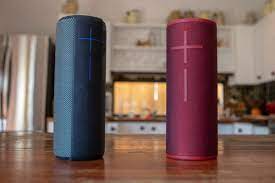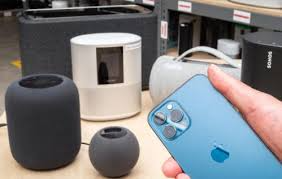1. Understanding Bluetooth Speaker Pairing
Bluetooth speaker pairing, a feature that has become increasingly popular in recent years, allows users to connect two or more Bluetooth speakers wirelessly. When paired, these speakers can work together to create a stereo sound experience or amplify the audio output for a larger space. The process involves linking two compatible speakers so they function as a single unit, with one acting as the left channel and the other as the right.
The core technology behind this is called “True Wireless Stereo” (TWS) or sometimes referred to as “Dual Audio” or “Stereo Pairing.” It enables each speaker to receive separate audio channels from a single source device such as a smartphone, tablet, or computer. This separation creates a sense of depth and spatial awareness, similar to what you’d get from a traditional stereo system.
However, it’s crucial to note that not all Bluetooth speakers support TWS pairing. To ensure compatibility, check your speakers’ specifications or user manual for mentions of dual pairing or stereo mode capabilities. Additionally, many modern speakers have built-in intelligence to automatically configure themselves once paired, but some may require manual configuration through buttons, settings menus, or companion apps.
Another important aspect to consider is the Bluetooth version. While newer versions like Bluetooth 5.0 generally offer better connectivity and range, it’s not the version itself that determines whether speakers can pair for stereo sound; it’s the implementation by the manufacturer. Always confirm the speaker’s ability to handle A2DP (Advanced Audio Distribution Profile), which is essential for transmitting high-quality stereo audio over Bluetooth.
In essence, pairing Bluetooth speakers offers an excellent solution for those seeking enhanced audio quality and flexibility without the clutter of wires. With the right setup, you can enjoy a portable, powerful, and immersive audio experience that transcends the limitations of a single speaker.
2. Choosing Compatible Speakers
Choosing compatible Bluetooth speakers for pairing is a critical step in setting up a wireless stereo system or enhancing your audio experience. Compatibility isn’t just about the brand; it’s about specific features and technical specifications that ensure seamless integration and optimal performance.
1. Check for TWS Support:
True Wireless Stereo (TWS) is the key feature to look for when selecting Bluetooth speakers for pairing. This technology allows two speakers to connect wirelessly and play separate left and right audio channels, creating a stereo effect. Not all speakers have this functionality, so check the product description or manual to confirm if they support TWS or dual pairing mode.
2. Same Model or Manufacturer Pairing:
Many manufacturers design their speakers to pair seamlessly with each other, especially within the same model series. While it’s not always necessary to use identical speakers, using the same brand can simplify the pairing process and guarantee compatibility. Some brands also offer dedicated apps that facilitate the setup of paired speakers.
3. Bluetooth Version:
While any version of Bluetooth should allow basic connectivity, newer versions like Bluetooth 5.0 provide better range, stability, and potentially faster connection times. However, the version doesn’t necessarily determine TWS capability. Ensure that both speakers support A2DP (Advanced Audio Distribution Profile), which is crucial for transmitting high-quality stereo audio.
4. Audio Quality and Features:
Pairing two speakers does not automatically guarantee improved sound quality. Each speaker should have good individual audio fidelity and power output. Additionally, consider whether they offer equalizer settings, bass boost, or other features that can be adjusted to balance the stereo field and enhance the listening experience.
5. Battery Life and Charging:
When pairing speakers, you’re effectively doubling your playback time but also potentially doubling energy consumption. Make sure both speakers have adequate battery life to sustain the desired listening duration, and consider whether they come with fast charging capabilities.
6. Physical Considerations:
Size, shape, and design of the speakers can impact how well they work together in terms of acoustics and placement. For example, portable speakers with similar dimensions might produce a more balanced stereo image than vastly different sizes.
In conclusion, choosing compatible Bluetooth speakers involves considering several factors beyond just brand and aesthetics. Careful research and understanding of the technical aspects will lead to a harmonious pairing that maximizes your audio enjoyment.
3. Initiating the Pairing Process
The method for pairing two Bluetooth speakers varies depending on the brand and model. Here’s a general step-by-step guide:
Step 1: Turn off any previously connected devices from both speakers’ memories.
Step 2: Power on both speakers and place them within a reasonable distance (typically around 30 feet) from each other.
Step 3: Enter pairing mode on one speaker by pressing and holding the Bluetooth button until it starts flashing. This indicates it’s ready to be paired.
Step 4: For the second speaker, look for a specific dual pairing function. Sometimes, this involves pressing a dedicated button or using a companion app to initiate stereo pairing mode.
Step 5: Once the first speaker detects the second speaker, it will automatically connect and configure the left and right channels. If using an app, follow the on-screen instructions to complete the pairing process.
4. Using Companion Apps for Easier Pairing
Many modern Bluetooth speakers come with companion apps that streamline the pairing process. These apps can help identify compatible speakers, guide you through setup, and manage advanced settings like equalizer adjustments and stereo configurations. Download and install the app for your speakers, then follow the in-app instructions to pair your speakers quickly and efficiently.
5. Troubleshooting Common Pairing Issues
If you encounter difficulties pairing your speakers, try these troubleshooting tips:
- Restart both speakers and your device playing the audio.
- Reset the Bluetooth connection on your speakers and re-initiate pairing.
- Update the firmware of both speakers if available.
- Ensure there are no obstructions between the speakers that could interfere with the Bluetooth signal.
- If using an app, check for compatibility with your smartphone’s operating system.
6. Creating a Multi-Room Audio System
Some high-end Bluetooth speakers can form part of a multi-room audio system, allowing you to sync multiple speakers across different rooms. Brands such as Sonos, Bose, and Ultimate Ears provide platforms where you can pair speakers wirelessly and control them centrally from a single app. In these systems, stereo pairing is just one aspect of the broader capability to play different songs in each room or group several speakers to play synchronized music throughout your home.
7. Enhancing Your Listening Experience
Once your Bluetooth speakers are successfully paired, you’ll notice a significant improvement in the sound quality. With stereo pairing, the left speaker plays the left channel of a stereo track while the right speaker handles the right channel, creating a more natural and spatially accurate soundstage.
Additionally, pairing two speakers together increases volume output without distorting the sound, making it perfect for parties, outdoor events, or simply filling a larger space with music. You might even find features like bass boost, surround sound simulation, or customizable EQ settings that further enhance your listening pleasure.
Conclusion
In conclusion, pairing two Bluetooth speakers can significantly elevate your audio experience, provided your speakers support the feature. It may require some initial setup, but once done, you’ll be rewarded with richer, fuller sound that brings your favorite tunes to life. Always refer to the manufacturer’s instructions and consider leveraging companion apps to make the process as smooth and enjoyable as the stereo sound itself.